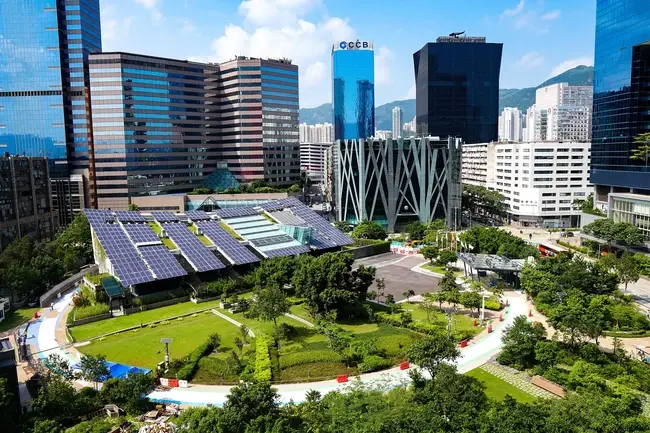Throughout the centuries, we’ve entertained the thought of securing a better, more sustainable future for our descendants. Yet, our actions have not always backed up these ideals. On the contrary, many things we do directly oppose the values we so proudly wear on our sleeves.
One of the most striking examples of this shortcoming is how we approach urban planning. Instead of developing new cities by anticipating future challenges and addressing them accordingly, we indulge in outdated and unnecessarily expensive ideas.
The latest example of this line of reasoning is the construction of the New Administrative Capital (NAC) in Egypt. Since 2015, it has already proven to be a significant financial liability for the country. And, with an estimated cost of $59 billion and the construction process being far from over, it doesn’t seem like this investment will pay back anytime soon.
It begs the question: is building sustainable cities in this day and age actually possible, and if so, what can we do to make it happen? Here’s what we know.

The Current Situation
According to a 2017 United Nations report, the world’s population is expected to reach 9.8 billion in 2050 and 11.2 billion in 2100. It paints a gloomy picture of the future, as many voices share the same concern: Can we provide food and shelter for these people?
On top of that, staying positive in a world heading for a recession is challenging. The Russian invasion of Ukraine and the highest global inflation in over 20 years have left only a few with the resolve needed to see the future through rose-tinted glasses.
Still, it is not all doom and gloom. Scientists and researchers make new technological advances each year, crafting new tools and designing innovative solutions that can help us build sustainable urban hubs.
The manufacturing of modern smart cities technology, such as solar panels and roof gardens, might hold the key to thriving in an increasingly industrialized world. However, all this effort will be for naught if we won’t use it.
What Can We Do To Change It?
To make a lasting impact on how our cities are built, we need to create new, sustainable guidelines and put every detail in place according to these fundamental city design principles. Besides focusing on water, food, and energy, we must consider other elements, such as waste and mobility.
Here are the critical areas we need to address to create more sustainable cities in the future:
Water
Having access to safe drinking water is one of the human rights. It is generally not an issue in the United States and the EU. Nevertheless, not everyone is so fortunate.
For example, people living in rural Sub-Saharan Africa rely on unprotected wells to satisfy their needs. On the other hand, in Africa and Asia, women walk an average distance of six kilometers to collect water.
It shows we still have a long way to go in terms of building cities with easy access to water.
Rainwater cleansing and protecting upland water systems are necessary to eliminate this problem. At the same time, sustainable land use that allows for wetland restoration can help people thrive by providing the water and food they need to survive.
Adhering to water-sensitive urban design (WSUD) can minimize environmental degradation and improve our cities’ aesthetic and recreational appeal. Using water-efficient appliances, stormwater harvesting, and other common WSUD techniques is a straightforward way to reduce our ecological footprint and build better urban areas.
Food
Just like people need water, they also need food. Fortunately, we can do something about this issue as well.
The latest developments in agriculture allow us to take advantage of advanced hydroponic technology for urban farming. It can help us provide food for all the people living in densely developed urban hubs of the future without polluting the environment.
Another potential solution is the concept of underground farming. Thanks to aeroponics, air-dynaponics systems, and container gardens, we can cultivate soil below ground level. Moreover, with artificial lighting provided by growth lamps or daylighting systems, we no longer need to depend on the environment above the ground.
While these solutions are costly to implement with current technologies, they may revolutionize the way we grow food in the coming years.
Energy
Energy is also a significant issue to discuss. With global warming becoming a threat with each passing year, we must find new ways to make our cities more sustainable in this department.
Building our cities to run on clean, renewable energy won’t be easy. Nonetheless, we’re making strides to see it happen.
Thanks to lighter and cheaper bladeless wind turbines, we could satisfy at least a portion of our energy needs without poisoning the environment. Nuclear energy and hydropower could provide the supplementary energy we require to live as we do today.
We should strive to create cities where enough power is produced within their walls to satisfy the needs of their inhabitants. Each metropolis should be self-sufficient, where area buildings share energy resources, generating as much energy as they consume.
Waste
Waste is an element of urban design many people forget about. However, it does not make it less important.
Proper waste management can help our cities produce more energy. For example, turning waste into clean fuels is an excellent way to eliminate pollution and simultaneously increase our maximum energy output.
In the cities of the future, all used items will be either reused or recycled. Many products will be biodegradable and need few resources to manufacture. And, since we will no longer need landfills, we will transform them into functional industrial areas used for other purposes after soil remediation.
Mobility
Another critical aspect of sustainable urban planning is mobility. People traveling for long hours to and from work — or anywhere, for that matter — is inefficient.
Just as building a new capital at the center of the desert makes little to no sense, creating a city where everyone has to travel long distances to go shopping or hang out at the park is a terrible design.
Instead, we must focus on investing in sustainable social transit.
Dense developments connected by high-speed rail will allow us to reach every place we need in a matter of minutes. And as an additional benefit, regional high-speed rail stations will become centers of business and social activities, improving the cultural life in the city.
With fewer cars on the road and more pedestrian space, cities will once again belong to their inhabitants — not loud vehicles that pollute the environment.
The Upshot
Creating sustainable cities is definitely within our grasp. If we make a collective effort to transform the way we think about urban landscapes and embrace the potential of renewable energy, we can achieve what our forefathers dreamt about.
That said, focusing on building sustainable cities with the utmost attention to critical factors, such as water, food, energy, waste, and mobility is probably the best shot at making our future less bleak.
Of course, the list of solutions presented in this article is not exhaustive. We may discover new answers by exploring old ideas or creatively using the latest inventions.
Either way, it is clear that changes are necessary to maintain our standard of living without destroying the planet.







Comments ( 0 )